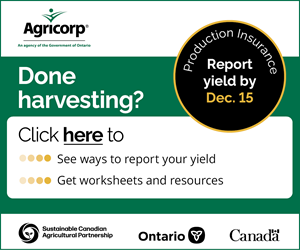No-till carbon credits program
REDUCING GREENHOUSE GAS EMISSIONS
ontario’s no-till farmers are eligible to take part in a new program that will reward farmers for environmental stewardship. “We’re getting great participation,” says Ben Currelly, the president of NorAg Resources Inc., a Port Hope-based national agricultural commodity merchandiser which launched its ‘No-Till Carbon Credit Program’ for Ontario grain farmers in December 2012.
The NorAg program provides growers with carbon credit sales benefits in exchange for verified reductions in greenhouse gas emissions achieved using no-till. The credits are available for sale through NorAg to companies and individuals who wish to reduce their ‘carbon footprint.’
“No-till significantly lowers the carbon emissions that come from fields over traditional tillage,” Currelly explains. “It sequesters carbon in the soil, and less carbon is therefore emitted from fields into the atmosphere. Fewer passes through the fields also mean fewer carbon emissions from burning fossil fuel.”
No-till also lowers emissions of nitrous oxide, a greenhouse gas emission 310 times more potent than carbon dioxide (CO2), and offers farmers additional benefits such as increased yield, reductions in fuel expense and improved soil quality.
the benefits
Dan Campbell is a no-till farmer who signed up with the program in December. He owns a 450 acre farm in central Lambton County, near Petrolia, with his wife Sharon. “We grow about half of our workable acres in soybeans and the remaining half is split between corn and winter wheat,” Campbell says. “Sharon and I do the work with some seasonal family help, including our three daughters.”
The family started no-tilling wheat and then soybeans in the early 1990’s. “One of the reasons that we use no-till is to reduce trips across our flat Brookston clay soils,” Campbell says. “Reducing soil compaction and conserving organic matter is the main driver behind most of our fieldwork decisions. That also means we do some tillage to incorporate the wheat straw, which we do not remove since we value the organic matter benefits. Typically, the higher our soil organic matter, the better our crop drought resistance is and the better the tilth of our soils.” The Campbells also utilize cover crops such as red clover plow-down to increase soil organic matter.
Being in the carbon credit program, in Campbell’s view, is a good way to quantify some of the positive changes they’ve made in their farming practices over the last few years. “Our soils are draining better now that we do less tillage, due to the preservation of earthworm holes and the reduction in compaction,” he notes. “Knowing how much carbon and organic matter we’re tying up in the soil is important when we sometimes question whether we might get better yields with tillage – and the monetary rewards from the carbon credit program will be an incentive to maximize the amount of no-till acres that we adapt.”
program details
There is no limit to the number of acres or farmers that can be signed up to the NorAg program. A single carbon credit is equivalent to one tonne of carbon dioxide or other greenhouse gas.
Currelly explains that one acre sequesters 0.1426 tCO2e per year. tCO2e stands for ‘tonnes of carbon dioxide equivalent.’ It is a measure for describing how much global warming a given type and amount of greenhouse gas may cause, using the functionally equivalent amount or concentration of CO2 as the reference.
“Therefore, if 300,000 acres were signed up for example, 42,500 tCO2e will be available for sale and the resulting funds distributed to participating farmers,” Currelly says. Like all markets, carbon credit market prices change on an ongoing basis.
It costs nothing for farmers to sign up and past acres can be registered from the years 2002 to 2012. “The deadline for sign up for the 2012 crop is March 15, 2013, and next year, the deadline for sign up for the 2013 crop will be March 15, 2014,” says Currelly.
Farmers can register online quickly and easily on the NorAg website, where those that apply will be prompted to provide details of their no-till practices. It takes about 20 minutes to register, and once approved, farmers will receive confirmation by email.
Verification of emission reductions are performed by an accredited third party. “NorAg will disclose a full accounting of costs and return proceeds to all participating farmers,” Currelly explains. “Participants also have the choice to donate proceeds to the Canadian Food Grains Bank for a charitable tax receipt.”
Currelly, who hails from a farming family, sees the program as “an opportunity to highlight the contributions that no-till farmers are making to fight climate change and to encourage others to do the same.”
Campbell agrees. “I am hopeful that many farmers can benefit from changes they make to reduce their carbon releases, and have their contributions to reducing greenhouse gases recognized,” he says. “I appreciate the opportunity to participate with NorAg in this program.”
For more on NorAg’s No-Till Carbon Credit Program, visit www.norag.ca or call
1-888-798-9666. •





















